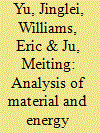|
|
|
Sort Order |
|
|
|
Items / Page
|
|
|
|
|
|
|
| Srl | Item |
| 1 |
ID:
097254


|
|
|
|
|
| Publication |
2010.
|
| Summary/Abstract |
Owing to booming mobile phone ownership and a short product innovation cycle, waste mobile phones are flooding China. In 2008, about 560 million mobile phones were produced and 634 million users subscribed to a mobile phone plan in China. These large numbers mean that the charging and disposal of mobile phones has the potential to have significant impacts on the environment. Thus the evaluation of material and energy consumption of mobile phones is an important task in the end-of-life management of electronic products. This paper uses material flow analysis (MFA) and life cycle assessment (LCA) methods to estimate the life cycle impacts of mobile phones in China from manufacturing energy, use phase and generation of waste mobile phones. Results indicate over the mobile phone life cycle, manufacturing accounts for 50% of the total energy consumption, whereas the use phase accounts for only 20%. Mobile phones and supporting infrastructures account for a rapidly increasing 0.17% of Chinese energy use. In 2008, around 77 million units of waste mobile phones were generated in China. To manage this energy use and recover valuable materials recommendations are made to increase lifespan, improve energy efficiency during use and ensure recycling.
|
|
|
|
|
|
|
|
|
|
|
|
|
|
|
|
| 2 |
ID:
111361


|
|
|
|
|
| Publication |
2012.
|
| Summary/Abstract |
A global alternative mix to fossil fuels is proposed, based on proven renewable energy technologies that do not use scarce materials. The mix consists of a combination of onshore and offshore wind turbines, concentrating solar power stations, hydroelectricity and wave power devices attached to the offshore turbines. Solar photovoltaic power could contribute to the mix if its dependence on scarce materials is solved. The most adequate deployment areas for the power stations are studied, as well as the required space. Material requirements are studied for the generation, power transport and for some future transport systems. The order of magnitude of copper, aluminium, neodymium, lithium, nickel, zinc and platinum that may be required for the proposed solution is obtained and compared with available reserves. Overall, the proposed global alternative to fossil fuels seems technically feasible. However, lithium, nickel and platinum could become limiting materials for future vehicles fleet if no global recycling systems were implemented and rechargeable zinc-air batteries would not be developed; 60% of the current copper reserves would have to be employed in the implementation of the proposed solution. Altogether, they may become a long-term physical constraint, preventing the continuation of the usual exponential growth of energy consumption.
|
|
|
|
|
|
|
|
|
|
|
|
|
|
|
|
|
|
|
|
|